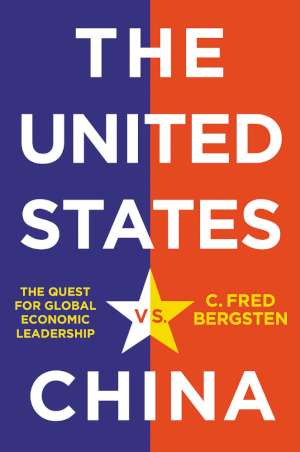25 July 2022
The United States vs. China
The Quest for Global Economic Leadership
C. Fred Bergsten
2022, Polity, 312 pages,
ISBN 9781509547357
Reviewer: Andrew Peaple

If you want a catch-up on the state of relations between the U.S. and China, a quick perusal of recent book titles will help. Tomes such as The Long Game, The Great Decoupling and Destined for War have all hit the shelves in recent years as the rivalry between the world’s leading economies has intensified.
The title of economist C. Fred Bergsten’s latest book, The United States vs. China - The Quest for Global Economic Leadership, might suggest it is another addition to this doom-mongering list. But it would be a disservice to characterize it as such. For sure, Bergsten’s book is full of realism about the current tenor of Sino-U.S. ties. But his painstakingly argued work offers practical suggestions for ways in which the two countries can co-operate to keep an economic relationship on track that he believes has benefited both sides hugely.
A key theme running through the book is the danger posed by two looming traps. The first, the so-called ‘Thucydides Trap’, is the idea that an incumbent hegemon like the U.S. is bound to come into conflict with a rising rival. Bergsten spends comparatively little time on this, a topic that has been covered at length elsewhere. He is more preoccupied with the so-called ‘Kindleberger trap’, in which neither a declining world power nor the upcoming challenger are willing to take on global economic leadership, leaving the world vulnerable to the kind of downward spiral into depression and conflict most notably seen in the 1930s.
Bergsten is worried that we are at such a juncture again. He sets out at length the reasons for confidence that China will achieve economic parity with the U.S. sooner or later — and why it would be both foolish and difficult to constrain its rise. But he also questions whether Beijing is ready or willing to assume leadership of the global economy, both for political and practical reasons, such as the continuing small role of the renminbi in the world’s financial system.
He worries, too, that the U.S. could slide back into isolationism — he reserves particular scorn for the policies of what he calls the ‘Trump abdication’. And while he considers the possibility that others, such as the EU, could step up in the advent of a G-0 world, his clear feeling is that an unstable leadership vacuum is more likely.
Bergsten’s solution is built on the premise that Washington and Beijing can somehow de-link their mutual economic interests from the rest of their relationship. He calls for ‘conditional competitive co-operation’ between the two countries, an alliterative if somewhat clunky addition to the list of phrases put forward over the years by a plethora of China-watchers to describe how the U.S. and China should interact — a list Bergsten himself provides, from Henry Kissinger’s ‘co-evolution’ to Kevin Rudd’s ‘managed strategic competition’ to David Shambaugh’s ‘competitive coexistence’.
Bergsten’s vision is for the U.S. to compete vigorously in the economic realm day-to-day with China, and to co-operate with it conditioned on fully reciprocal behaviour from Beijing — all predicated on an acceptance that there is a rough equivalence of economic power between the two countries. Bergsten offers a variety of practical ways to achieve this, from the formation of an informal G-2 (even if that moniker is avoided so as not to antagonize the likes of the EU or Japan), to granting China full voting parity with the IMF and the U.S. joining the Beijing-led Asia Infrastructure Investment Bank, along with recommendations to reinvigorate the global trade system.
The argument is cogent and comprehensive: In the course of the book Bergsten covers all of the major flashpoints and controversies of recent years, always readably. The major question surrounding his conclusion is whether it is really possible for the U.S. and China to somehow carry on a civilized relationship in the economic sphere, amid deepening hostility over issues from Xinjiang to Hong Kong to human rights and, of course, Taiwan. It is hard to see any U.S. administration having the political capital to, say, co-operate on global trade and infrastructure — as Bergsten hopes — when the atmosphere in both countries’ capitals has become so mutually antipathetic. If sane heads like Bergsten were running the world, maybe it would be possible. Based on the evidence of this book, it is a shame he is not among those currently in the corridors of power.
